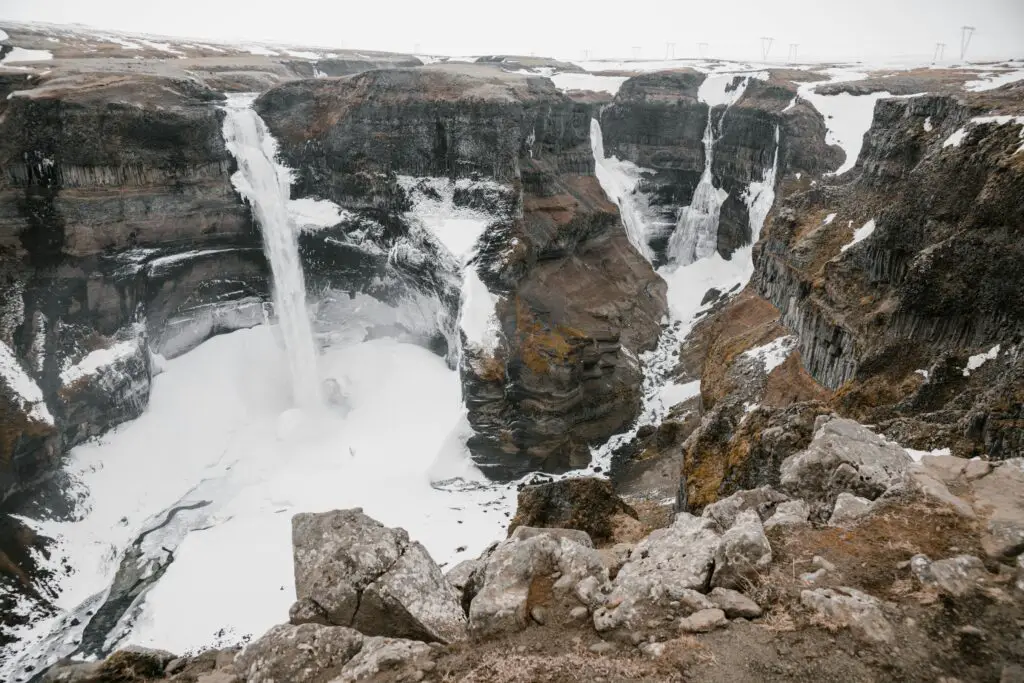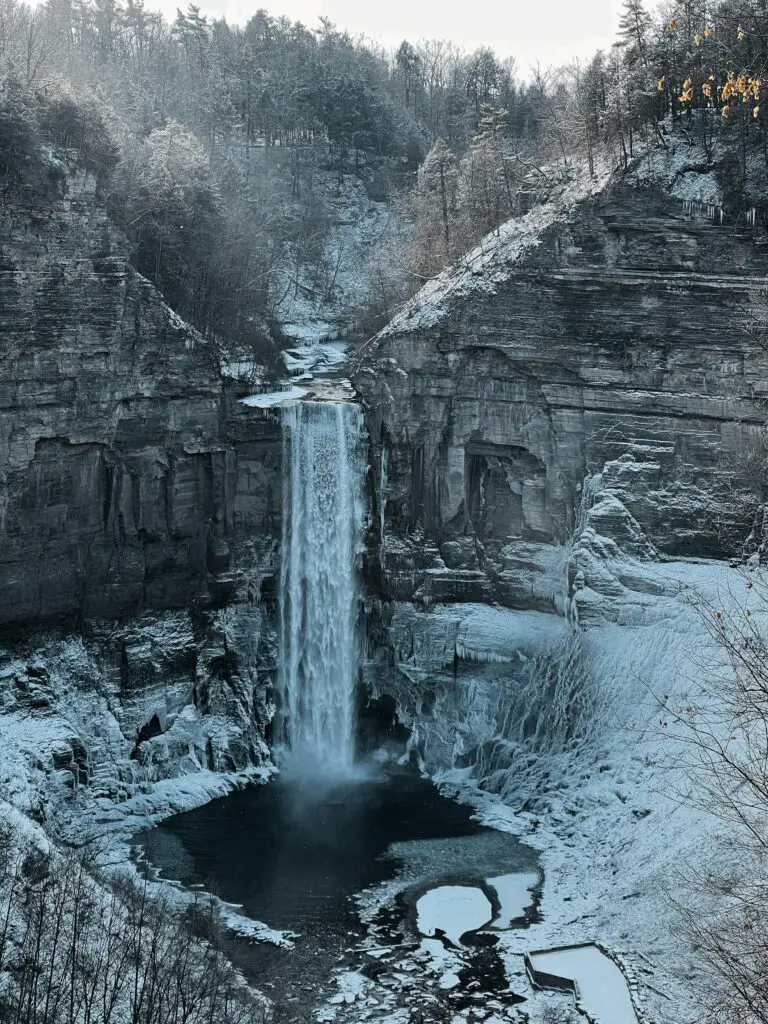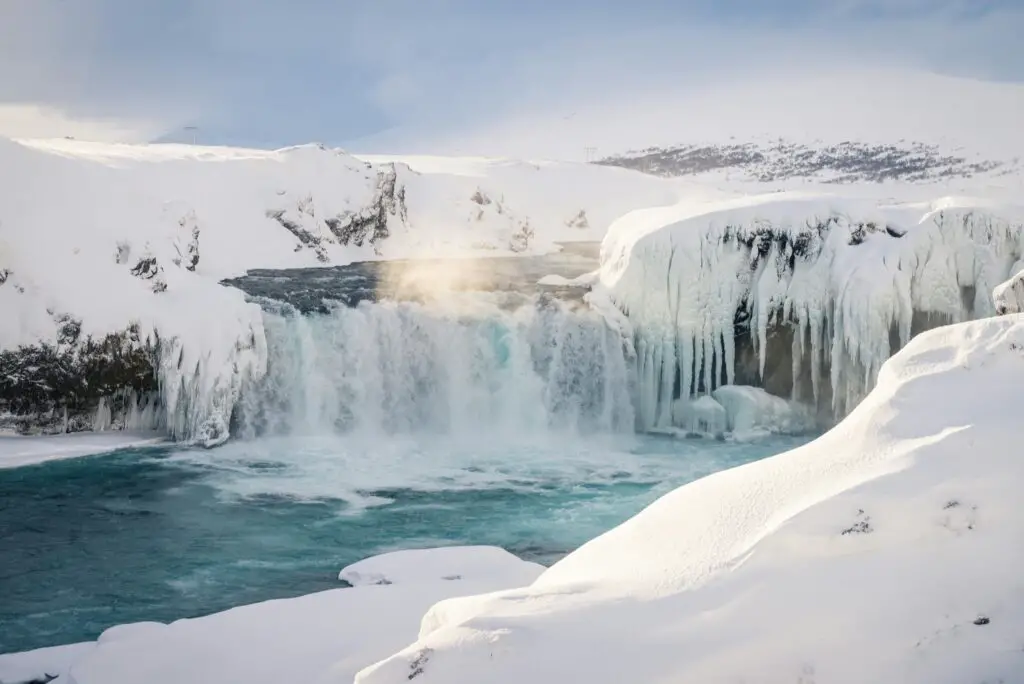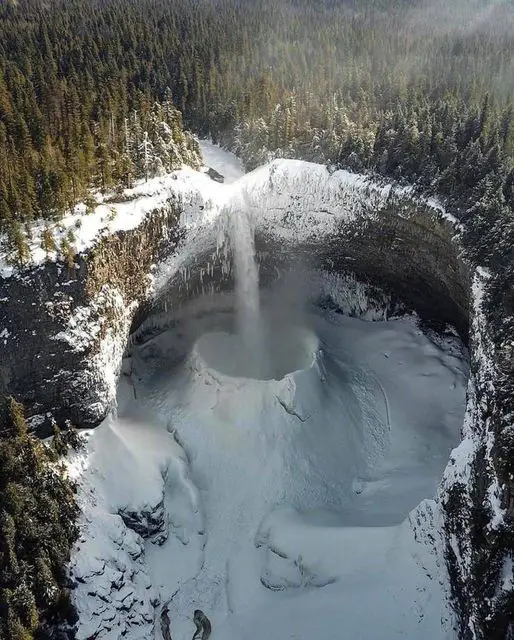It’s me, your overly enthusiastic guide, here to take you on an adventure to one of nature’s most magical wonders – the frozen waterfall! Bundle up and get ready to venture into an icy palace filled with sparkling sculptures and thundering echoes. We’ll scale slippery slopes, squeeze through frozen fractures, and stand speechless before nature’s might on full display. I can’t wait for you to experience the bone-chilling thrills and awestruck inspiration that await behind the icy veil! Our journey begins now to a place frozen in time, where the stillness comes alive and everyday worries fade away. Let’s discover the wonders of the frozen waterfall together!

The Magic of Frozen Waterfalls
A Winter Wonderland
The frozen waterfall is one of nature’s most spectacular winter wonders. As the frigid air turns water into ice, a cascade is magically transformed into a glittering crystal palace. The icy granite walls sparkle, catching the sun’s rays and reflecting every color of the rainbow. It’s like stumbling upon an enchanted ice castle hidden deep in the forest.
Exploring the Ice
Approaching the frozen falls, I crunch through the snow, captivated by the intricate ice formations. Delicate icicles hang like chandeliers while frosty ferns and feathers sprout from the rock. I place my hand on the icy surface, feeling the cold through my mitten. The waterfall has been frozen in time, its churning waters stilled into a glassy sheen.
A Temporary Wonder
Though the frozen waterfall seems timeless, I know its beauty is fleeting. When the temperatures rise and the days grow longer, the ice will thaw and the waters will flow free once more. The waterfall will awaken from its winter slumber, the crystal palace will melt away, and this magical place will disappear until next year. But for now, I soak in the wonder of this temporary ice world, an ephemeral gift of nature in the depths of winter.
Where to Find Frozen Waterfalls Around the World
Iceland
Have you seen photos of massive ice columns and icy cliffs? Those surreal frozen landscapes can only be found in Iceland! During winter, waterfalls like Gullfoss and Dettifoss transform into glittering ice sculptures. The sight of these thundering falls frozen in time is simply magical. Pack your warmest coat and head to Iceland for an unforgettable adventure exploring some of the most stunning frozen waterfalls on the planet!
Yosemite National Park, California
In Yosemite Valley, towering waterfalls are dazzling any time of year but especially spectacular when frozen. After a snowstorm, hike the Mist Trail to see massive icicles clinging to the cliffs around Vernal Fall and Nevada Fall. The icy spray from the falls forms natural ice bridges and tunnels. It’s like walking through an enchanted ice kingdom! The stunning views of snow-capped peaks and frozen falls make braving the cold absolutely worth it.
Plitvice Lakes National Park, Croatia
Have you seen photos of travertine lakes with ethereal turquoise water and dramatic waterfalls? Plitvice Lakes National Park is home to those otherworldly vistas. In winter, the park transforms into a frosted wonderland, especially dazzling when the waterfalls freeze into intricate ice formations. The boardwalks around the lakes get coated in ice, making you feel like you’re walking on clouds. The contrast of the frozen waterfalls against the snowy forests is straight out of a fairy tale. Plitvice Lakes in winter is pure magic!

How Do Waterfalls Freeze? The Science Behind It
Have you ever wondered how massive flowing waterfalls turn into icy wonders during winter? It’s a magical sight, but the science behind it is actually quite fascinating.
The Flow Slows Down
As temperatures drop, the water flowing over the waterfall begins to slow down. Moving water is harder to freeze because it’s constantly being disturbed. But when the flow rate decreases, the water molecules have more time to form bonds and crystallize into ice.###
Less water is flowing in from the top of the waterfall, and whatever water is left moves more sluggishly. The rocks, ledges and surfaces of the waterfall provide spots for the ice crystals to cling to and build upon. Little by little, chunks of ice accumulate until the entire waterfall is transformed into a frozen spectacle.
The Temperature Drops Below Freezing
For waterfalls to freeze over completely, the temperature needs to stay below freezing for a sustained period of time. As the thermometer dips lower and lower, more and more of the waterfall turns to ice. The freezing point of water is 32°F or 0°C, so once the temperature drops below that point, the magic begins!
The Ice Spreads Outward
The ice typically starts to form around the edges and surfaces of the waterfall, where the water is in contact with the air. It then spreads inward, covering the rocks and any other surfaces in its path. The ice builds up layer by layer, spreading horizontally across the width of the falls while also climbing vertically.
Before you know it, nature has crafted a magnificent ice palace where a flowing waterfall once stood. The end result is nothing short of breathtaking. Every frozen waterfall has its own unique icy formations, patterns and shapes.
Witnessing the transformation of a powerful waterfall into a frozen winter wonderland before my eyes fills me with a sense of awe and delight. The spectacular icy fortress nature has created simply amazes me every time. Now you understand the science behind the magic – just add falling temperatures and flowing water, then watch as nature puts on a dazzling display!
Top Tips for Photographing Frozen Waterfalls
I absolutely love photographing frozen waterfalls in the winter! There’s something magical about seeing flowing water transformed into icy sculptures. If you’re ready to embark on your own frozen waterfall photography adventure, here are my top tips to help you capture these natural wonders.
Get there early!
The best light for photography is often the golden hours just after sunrise and before sunset. Since the winter days are short, you’ll want to get to the location as early as possible to make the most of the limited daylight. Early morning light filtering through the icy falls will make for stunning images.
Use a longer focal length.
A longer zoom lens, like 70-200mm, is ideal for compressing the scene and capturing the details in the ice. If you only have a kit lens, zoom in as much as possible. Getting up close to the falls will allow you to highlight the textures and abstract patterns in the ice.
Play around with shutter speeds.
Using a longer shutter speed, like 1/2 second or longer, will give the water a silky, blurred effect. For sharper shots, use a faster shutter speed of 1/250 sec or higher. Take a variety of shots at different shutter speeds and apertures to give yourself options to choose from later.
Get creative with angles and composition.
Don’t just take shots from eye level—get high or low for an unusual vantage point. Try vertical and horizontal compositions, or zoom in on interesting details for macro shots. Move around to find the most photogenic spots and angles of the falls. A variety of compositions will make your gallery of images much more compelling.
Photographing frozen waterfalls takes patience and practice. But with the right light, equipment, and creative vision, you’ll be capturing stunning images of these fleeting winter wonders in no time! So bundle up, grab your camera, and get out there—a new world of ice awaits!

Safety First! Frozen Waterfall Hiking Essentials
Exploring a frozen waterfall is a thrilling winter adventure, but safety should always come first. As an avid hiker, I never head out without the essential gear to keep me comfortable and protected.###
Proper footwear is a must for traversing icy terrain. I prefer insulated hiking boots with rugged, slip-resistant soles and gaiters to keep snow out. Crampons or microspikes provide extra traction on slick surfaces. I also bring trekking poles for balance and a pair of waterproof gloves or mittens.
Staying warm and dry is key. I layer up with thermal undergarments, insulated pants, a heavy winter jacket, hat, and scarf. For extreme conditions, a down parka is ideal. I always pack emergency gear like a space blanket, fire starter, flashlight, food, and water. You never know when weather conditions may change or if an accident could occur.
Even with the right gear, hiking on frozen waterfalls can be dangerous if you’re not experienced. I recommend going with an experienced guide the first time. They know how to assess ice conditions and choose routes that minimize the risk of falling through. As the old saying goes, it’s better to be safe than sorry!
Before I head out, I check local ice and weather conditions to determine if it’s safe. The ice should be at least 4 to 6 inches thick for walking. I also let someone know my hiking plans in case of emergencies. Exploring frozen waterfalls is exciting, but never worth putting your safety at risk. With the proper precautions taken, you’ll be enjoying nature’s ice palace in no time!





